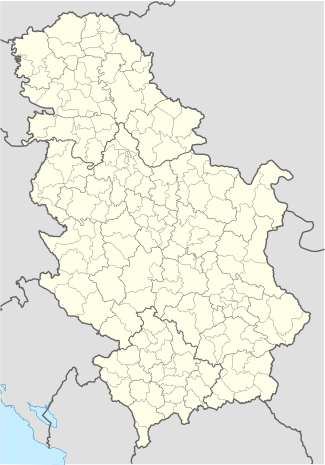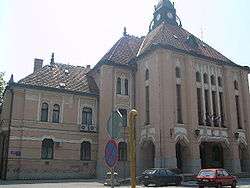Kanjiža
| Kanjiža Кањижа Magyarkanizsa | ||
|---|---|---|
| Municipality and City | ||
|
City hall | ||
| ||
 Kanjiža Location of Kanjiža within Serbia | ||
| Coordinates: 46°04′N 20°03′E / 46.067°N 20.050°ECoordinates: 46°04′N 20°03′E / 46.067°N 20.050°E | ||
| Country | Serbia | |
| Province | Vojvodina | |
| District | North Banat | |
| Government | ||
| • Mayor | Róbert Fejsztámer | |
| Area | ||
| • Kanjiža | 400 km2 (154 sq mi) | |
| Population (2011) | ||
| • Kanjiža | 9,871 | |
| • Metro | 25,343 | |
| Demonym(s) | Kanjiža, (sr) | |
| Time zone | CET (UTC+1) | |
| • Summer (DST) | CEST (UTC+2) | |
| Postal code | 24420 | |
| Area code(s) | +381(0)24 | |
| Car plates | KA | |
| Website | http://www.kanjiza.rs | |
Kanjiža (Serbian: Кањижа / Kanjiža, pronounced [kǎɲiʒa], formerly Стара Кањижа / Stara Kanjiža; Hungarian: Kanizsa or Magyarkanizsa) is a town and municipality in the North Banat District of Vojvodina, Serbia. The Kanjiža town has a population of 9,871, while the Kanjiža municipality has 25,343 inhabitants.
Geography
Although it belongs to North Banat District, territory of Kanjiža municipality is in fact located in the region of Bačka. The territory of the municipality is bordered by the river Tisa and the Novi Kneževac Municipality in the east, the Municipality of Senta in the south, the Municipality of Subotica in the west and the border with Hungary in the north. The proximity to the border, to the free-way and the river Tisa makes it an important location.
History
The town was mentioned in the Gesta Hungarorum chronicle under the name Kenesna and, according to the chronicle, it belonged to the duchy of Bulgarian duke Salan who ruled from Titel in the 9th century.[1] In first written documents after Hungarian conquest of Central Europe, the town is mentioned as Cnesa or Kenesna. This name came from Slavic word knez 'prince'. In 1335, it was mentioned as Villa Canysa.[2]
In the first half of the 16th century, the town was administered by the Eastern Hungarian Kingdom, until 1552 when it was administered by the Ottoman Empire (Sanjak of Çanad). From 1686 to 1918, the town was administered by the Habsburg Monarchy. Initially, it was part of the Habsburg Military Frontier, but was placed under civil administration in 1751. In the beginning of Ottoman administration, local Hungarian population left from this area. During the Ottoman period[2] and also during the first decades of Habsburg administration, the town was mainly populated by ethnic Serbs. Hungarian colonists from northern counties of the Kingdom of Hungary started to settle here in 1753 and they became dominant ethnic group in the town.[3] Since 1918, the town was part of the Kingdom of Serbs, Croats and Slovenes (Yugoslavia) and subsequent South Slavic states.

Inhabited places
Municipality of Kanjiža includes the town and 12 villages. The villages are:
- Adorjan (Adorján)
- Doline (Völgyes)
- Horgoš (Horgos)
- Male Pijace (Kispiac)
- Mali Pesak (Kishomok)
- Martonoš (Martonos)
- Novo Selo (Újfalu)
- Orom (Orom)
- Totovo Selo (Tóthfalu)
- Trešnjevac (Oromhegyes)
- Velebit
- Zimonić (Ilonafalu)
Note: For the inhabited places with Hungarian ethnic majority, the names are also given in italics in Hungarian.
Demographics (2011 census)


Ethnic groups in the municipality
The population of the Kanjiža municipality is composed of:[4]
- Hungarians = 21,576 (85.13%)
- Serbs = 1,830 (7.22%)
- Roma = 596 (2.35%)
- Romanians = 269 (1.06%)
- Others and undeclared = 1341 (5.29%)
Almost all of the settlements in the municipality have Hungarian majorities except Velebit, which is predominantly Serbian.
Ethnic groups in the town
The population of the Kanjiža town is composed of:[5]
- Hungarians = 8,319 (84.28%)
- Serbs = 894 (9.06%)
- Others and undeclared = 658 (6.67%)
Economy
The economy of Kanjiža is a healthy one dominated by the Potisje-Tondach roof tile factory. Other successful firms are FIM Kanjiža, Keramika Kanjiža, various paprika refining firms, one of the best spa health centers in Serbia - "Banja Kanjiža", etc.
Notable citizens
- Đorđe Krstić, renowned Serbian realist painter.
- Dan Reisinger, noted Israeli designer of graphics, exhibitions, and stage sets.
- Dragan Bošnjak, former Serbian football player
See also
References
- ↑ http://keptar.niif.hu/000500/000586/magyaro-honf-terkep_nagykep.jpg
- 1 2 Početak nastanka (in Serbian), Official website, retrieved 2013-11-29
- ↑ Razdoblje posle Turaka (in Serbian), Official website, retrieved 2013-11-29
- ↑ "Population by ethnicity – Kanjiža". Statistical Office of the Republic of Serbia (SORS). Retrieved 23 February 2013.
- ↑ "Population by ethnicity, urban settlements – Kanjiža". Statistical Office of the Republic of Serbia (SORS). Retrieved 23 February 2013.
External links
- The official website of the municipality
- Center for Information and Development of the Tisa region
- Kanjiza film (blog)
- Kanjiza Spa
- History of Kanjiža (Hungarian)
| Wikimedia Commons has media related to Kanjiža. |




